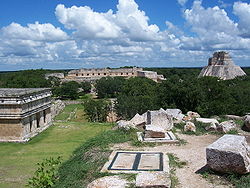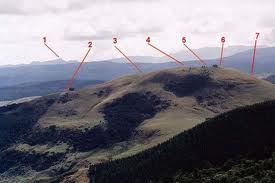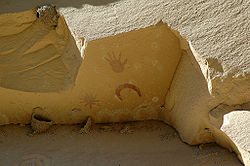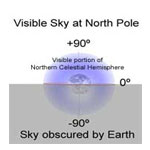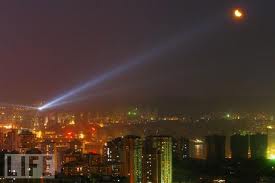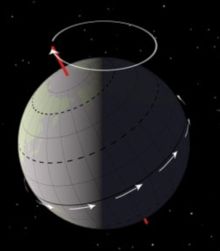- Latest Archaeology Updates
- Importance and applicability
- Famous Archaeologists
- Museums Collections
- Site Map
- World Heritage Sites
- World History Monuments
- Archaeological Organizations
- World Atlas of Archaeology
- Forensic Investigation and Geophysics
- Contact Us
- Movies based on Archaeology
- Frequently Asked Questions
- Archaeological discoveries
- Tell a Friend
- Archaeological Abbreviations
- Gallery Collections
- Famous-Museums site map
- Famous-archaeologists site map
- Archaeological Monuments site map
Archaeoastronomy is the study of how people in the past "have understood the phenomena in the sky, how they used phenomena in the sky and what role the sky played in their cultures." Clive Ruggles argues it is misleading to consider archaeoastronomy to be the study of ancient astronomy, as modern astronomy is a scientific discipline, while archaeoastronomy considers other cultures' symbolically rich cultural interpretations of phenomena in the sky.
It is often twinned with ethnoastronomy, the anthropological study of skywatching in contemporary societies. Archaeoastronomy is also closely associated with historical astronomy, the use of historical records of heavenly events to answer astronomical problems and the history of astronomy, which uses written records to evaluate past astronomical practice.
Archaeoastronomy uses a variety of methods to uncover evidence of past practices including archaeology, anthropology, astronomy, statistics and probability, and history. Because these methods are diverse and use data from such different sources, the problem of integrating them into a coherent argument has been a long-term issue for archaeoastronomers.
Archaeoastronomy fills complementary niches in landscape archaeology and cognitive archaeology. Material evidence and its connection to the sky can reveal how a wider landscape can be integrated into beliefs about the cycles of nature, such as Mayan astronomy and its relationship with agriculture.Archaeoastronomy can be applied to all cultures and all time periods. The meanings of the sky vary from culture to culture; nevertheless there are scientific methods which can be applied across cultures when examining ancient beliefs.
The term archaeoastronomy was first used by Elizabeth Chesley Baity (at the suggestion of Euan MacKie) in 1973, but as a topic of study it may be much older, depending on how archaeoastronomy is defined. Clive Ruggles says that Heinrich Nissen, working in the mid-nineteenth century was arguably the first archaeoastronomer. Rolf Sinclair says that Norman Lockyer, working in the late 19th and early 20th centuries, could be called the 'father of archaeoastronomy.' Euan MacKie would place the origin even later, stating: "the genesis and modern flowering of archaeoastronomy must surely lie in the work of Alexander Thom in Britain between the 1930s and the 1970s.
There is no one way to do Archaeoastronomy. The divisions between archaeoastronomers tend not to be between the physical scientists and the social scientists. Instead it tends to depend on the location of kind of data available to the researcher. In the Old World, there is little data but the sites themselves; in the New World, the sites were supplemented by ethnographic and historic data. The effects of the isolated development of archaeoastronomy in different places can still often be seen in research today. Research methods can be classified as falling into one of two approaches, though more recent projects often use techniques from both categories.
- Green archaeoastronomy
- Brown archaeoastronomy
- Green archaeoastronomy
- Brown archaeoastronomy
Because archaeoastronomy is about the many and various ways people interacted with the sky, there are a diverse range of sources giving information about astronomical practices.
Archaeoastronomy Source materials Consider
- Alignments
- Artifacts
- Art and inscriptions
- Ethnographies
An alignment is calculated by measuring the azimuth, the angle from north, of the structure and the altitude of the horizon it faces The azimuth is usually measured using a theodolite or a compass. A compass is easier to use, though the deviation of the Earth's magnetic field from true north, known as its magnetic declination must be taken into account.
An artifacts such as the Sky Disc of Nebra, alleged to be a Bronze Age artefact depicting the cosmos, the analysis would be similar to typical post-excavation analysis as used in other sub-disciplines in archaeology. An artefact is examined and attempts are made to draw analogies with historical or ethnographical records of other peoples. The more parallels that can be found, the more likely an explanation is to be accepted by other archaeologists.
A more mundane example is the presence of astrological symbols found on some shoes and sandals from the Roman Empire. The use of shoes and sandals is well known, but Carol van Driel-Murray has proposed that astrological symbols etched onto sandals gave the footwear spiritual or medicinal meanings.This is supported through citation of other known uses of astrological symbols and their connection to medical practice and with the historical records of the time.
Art and inscriptions may not be confined to artefacts, but also appear painted or inscribed on an archaeological site. Sometimes inscriptions are helpful enough to give instructions to a site's use.More problematic are those cases where the movement of the Sun at different times and seasons causes light and shadow interactions with petroglyphs. A widely known example is the Sun Dagger of Fajada Butte at which a glint of sunlight passes over a spiral petroglyph.
It is helpful when petroglyphs are associated with existing peoples. This allows ethnoastronomers to question informants as to the meaning of such symbols.
The historical records of the Conquistadores are a rich source of information about the precolumbian Americans. Ethnographers also provide material about many other peoples.In parts of Mesoamerica this was considered a significant day as it would herald the arrival of rains, and so play a part in the cycle of agriculture. This knowledge is still considered important amongst Mayan Indians living in Central America today.
Once the researcher has data to test, it is often necessary to attempt to recreate ancient sky conditions to place the data in its historical environment.
Topic Recreating the ancient sky is considered by
- Declination
- Solar positioning
- Lunar positioning
- Stellar positioning
- Transient phenomena
While the stars are fixed to their declinations the Sun is not. The rising point of the Sun varies throughout the year. It swings between two limits marked by the solstices a bit like a pendulum, slowing as it reaches the extremes, but passing rapidly through the mid-point. If an archaeoastronomer can calculate from the azimuth and horizon height that a site was built to view a declination of +23.5 then he or she need not wait until 21 June to confirm the site does indeed face the summer solstice.
The Moon's appearance is considerably more complex. Its motion, like the Sun, is between two limits known as lunastices rather than solstices. However, its travel between lunastices is considerably faster. It takes a sidereal month to complete its cycle rather than the year long trek of the Sun. This is further complicated as the lunastices marking the limits of the Moon's movement move on an 18.6 year cycle. For slightly over nine years the extreme limits of the moon are outside the range of sunrise. For the remaining half of the cycle the Moon never exceeds the limits of the range of sunrise. However, much lunar observation was concerned with the phase of the Moon. The cycle from one New Moon to the next runs on an entirely different cycle, the Synodic month.
Finally there is often a need to correct for the apparent movement of the stars. On the timescale of human civilisation the stars have maintained the same position relative to each other. Each night they appear to rotate around the celestial poles due to the Earth's rotation about its axis. However, the Earth spins rather like a spinning top. Not only does the Earth rotate, it wobbles. The Earth's axis takes around 25,800 years to complete one full wobble.
The effect to the archaeoastronomer is that stars did not rise over the horizon in the past in the same places as they do today. Nor did the stars rotate around Polaris as they do now. In the case of the Egyptian pyramids, it has been shown they were aligned towards Thuban, a faint star in the constellation of Draco.
Additionally there are often transient phenomena, events which do not happen on an annual cycle. Most predictable are events like eclipses. In the case of solar eclipses these can be used to date events in the past. A solar eclipse mentioned by Herodotus enables us to date a battle between the Medes and the Lydians, which following the eclipse failed to happen, to 28 May, 585 BC.Other easily calculated events are supernovae whose remains are visible to astronomers and therefore their positions and magnitude can be accurately calculated.
In an ironic, provocative style, Professor Magli shows the limitations of orthodox archaeology in the face of astronomically-based artefacts and tries to understand what led the ancients to construct magnificent buildings such as the city ...
With the publication of this volume, most of the important historical records of East Asian astronomical observations are now accessible in English..
This volume summarises the proceedings of a conference which took place at the University of Oxford in September 1981.
- Archaeoastronomy is the study of how people in the past "have understood the phenomena in the sky, how they used phenomena in the sky and what role the sky played in their cultures.".
- Archaeoastronomy.com : Archaeoastronomy's goal is to understand how skywatchers of the past fashioned and refined systems for regulating their primitive calendars and for memorializing celestial events, both cyclical and unique. Often they relied on sunlight and shadow plays striking and passing across targets and designs aligned with Equinox, Solstice and Cross Quarter sunrises and sunsets.
-
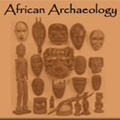 African Archaeology Africa has the longest record of human activity of any part of the world and along with its geographical extent; it contains an enormous archaeological resource. Scholars have studied Egyptology for centuries but archaeologists have only paid serious attention to the rest of the continent in more recent times.
African Archaeology Africa has the longest record of human activity of any part of the world and along with its geographical extent; it contains an enormous archaeological resource. Scholars have studied Egyptology for centuries but archaeologists have only paid serious attention to the rest of the continent in more recent times. -
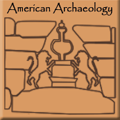 American Archaeology Archaeology of the Americas is the learning of the archaeology of North America, Central America (or Mesoamerica), South America and the Caribbean, which is to say, the pre-history and Pre-Columbian history of Native American peoples.
American Archaeology Archaeology of the Americas is the learning of the archaeology of North America, Central America (or Mesoamerica), South America and the Caribbean, which is to say, the pre-history and Pre-Columbian history of Native American peoples. -
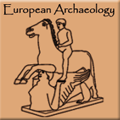 European Archaeology In terms of area, Europe is the world's second smallest continent, with an area of 10,400,000 kmē (4,000,000 square miles), making it slightly larger than Australia.
European Archaeology In terms of area, Europe is the world's second smallest continent, with an area of 10,400,000 kmē (4,000,000 square miles), making it slightly larger than Australia. -
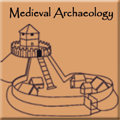 Medival archaeology The period covers the commotion caused by the fall of the Medival archaeology Roman Empire and cultures such as the Vikings, Saxons and Franks.
Medival archaeology The period covers the commotion caused by the fall of the Medival archaeology Roman Empire and cultures such as the Vikings, Saxons and Franks. -
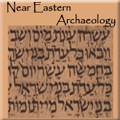 Near Eastern Archaeology Near Eastern Archaeology is a wide generalised application, and is divided into further regional sub-branches, the archaeology of modern states in the region or along broad thematic lines.
Near Eastern Archaeology Near Eastern Archaeology is a wide generalised application, and is divided into further regional sub-branches, the archaeology of modern states in the region or along broad thematic lines. -
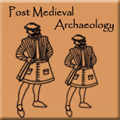 Post Medieval Archaeology The Post Medieval Archaeology is considered as a bi-annual journal study of the material evidence of European society. This period saw the conversion of medieval to industrial society.
Post Medieval Archaeology The Post Medieval Archaeology is considered as a bi-annual journal study of the material evidence of European society. This period saw the conversion of medieval to industrial society. -
 Modern Archaeology In contrast to the antiquarianism of classical archaeology, anthropological archaeology today is concerned with culture history (i.e., the chronology of events and cultural traditions) and the explanation of cultural processes.
Modern Archaeology In contrast to the antiquarianism of classical archaeology, anthropological archaeology today is concerned with culture history (i.e., the chronology of events and cultural traditions) and the explanation of cultural processes.


